
Building Construction
Brick, Brick Masonry Manufacturing of Bricks
BRICK MASONRY
The art of building structures using bricks and binding materials like cement (mortar) is called brick masonry.
STONE MASONRY
The art of building structures using stones and binding materials like cement (mortar) is called stone masonry.
BLOCK MASONRY
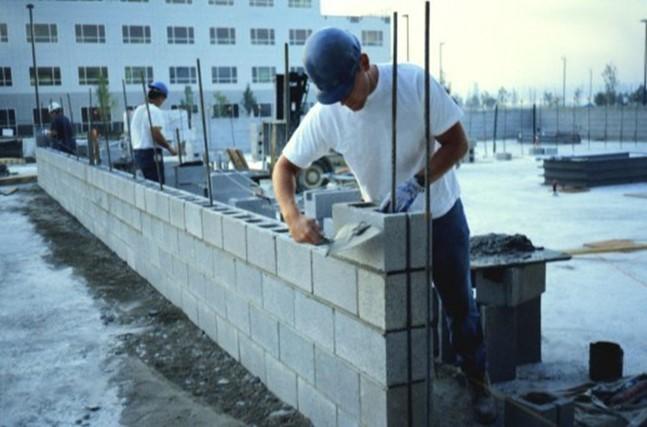
The art of building structures using concrete blocks with binding materials like cement (mortar)
is called block masonry.
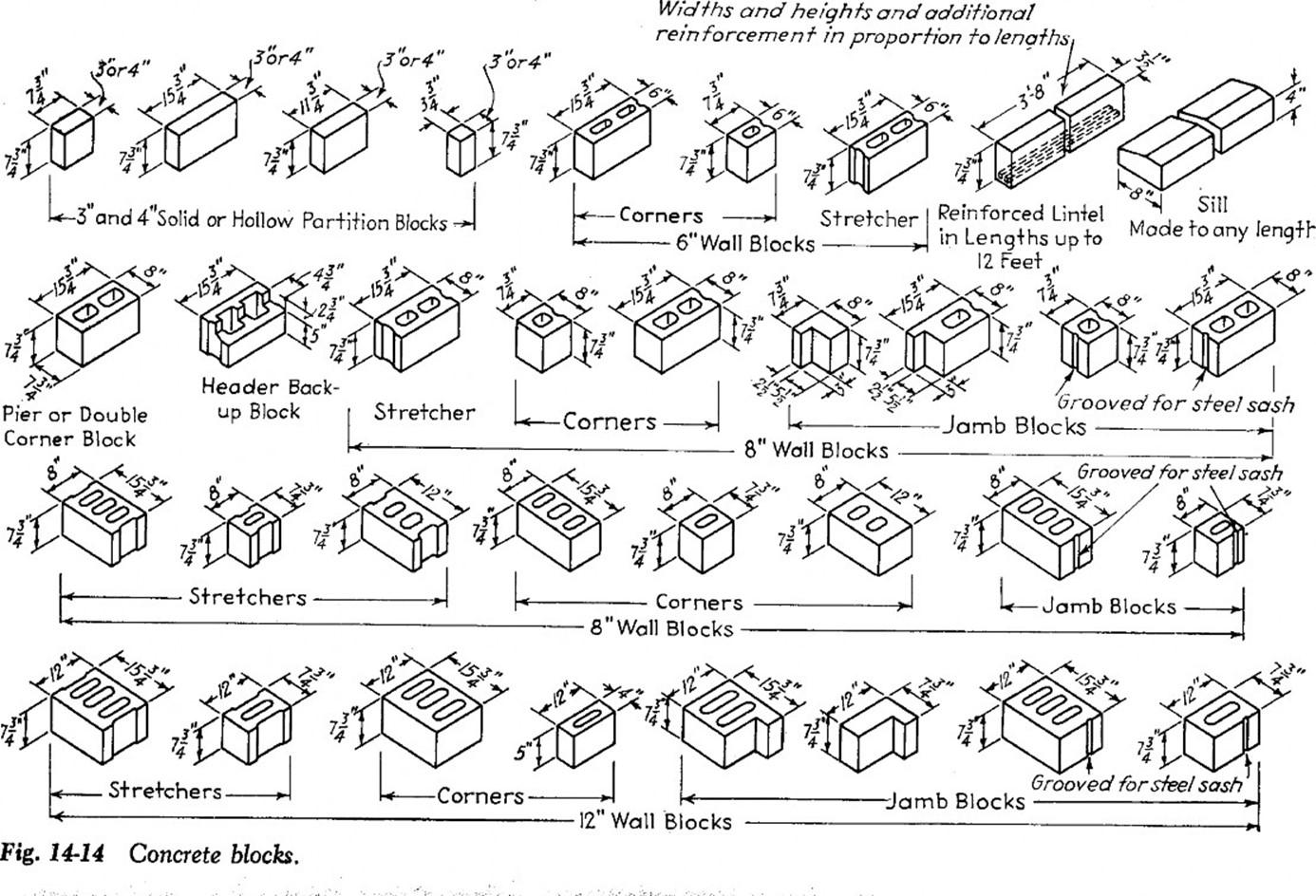
BLOCK MASONRY
Basic Terms of Brick
Brick is a basic building unit which is
in the form of rectangular block.
Standard size (Normal size) 9” ×4½” ×3″
or
(225 mm x112 mmx 75 mm)

- Header
-
Stretcher
Basics Terms
-
Arises
The edges formed by the intersection of plane surfaces of a brick are called arises.
-
Frog
The depression provided in the face of a brick during its manufacturing is called the frog.
-
Course
Each horizontal layer of bricks laid in mortar is called course.
-
Courses 
Frog

Arises
Basic Terms
Quoins
The external corners of a wall are called Quoins. And the bricks forming quoins are called quoin bricks. e.g. quoin header or quoins stretcher.
Perpends
The vertical joints of the bricks are called Perpends. The perpends of the alternate courses should be in the same vertical line
Perpends

Basic Terms
Jambs
It is the vertical sides of door or window opening to which the door is or window frame is attached.
Soffit
The under surface of any structural member such as a lintel, a slab is called Soffit.
Sill
The horizontal surface at the bottom side of a door or window opening is called sill.

Mortar
The mixture of binding material and fine aggregate forming a workable paste is called mortar.
Grout or slurry
The thin paste of cement is called grout or slurry. It is used to fill the joints.
Lintel
A small horizontal member to span up small opening is called lintel.
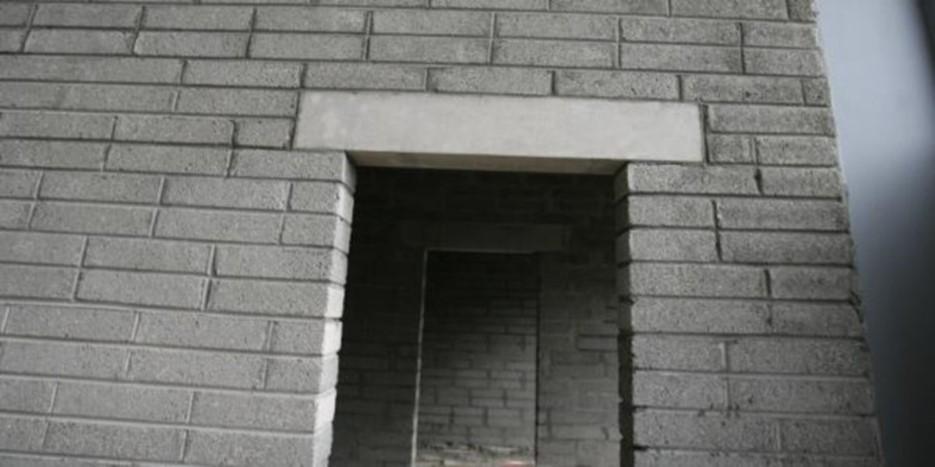
Types of Closer : King Closer
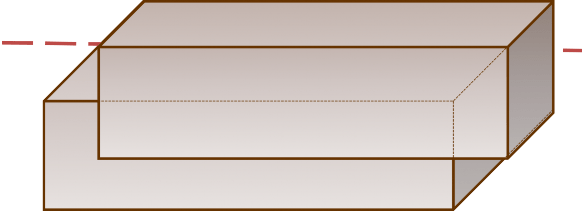
Types of Closer : Queen Closer
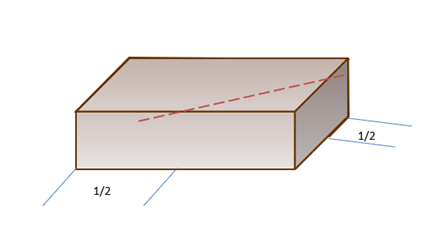
Types of Closer : Mitred Closer
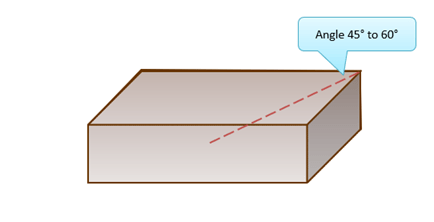
Types of Closer : Bevelled Closer
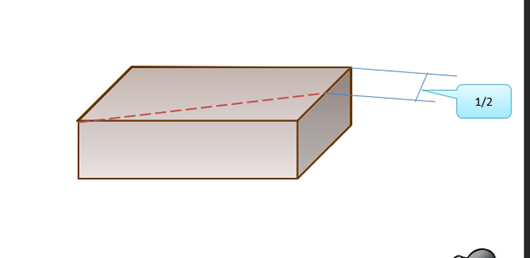

Bat 1/2
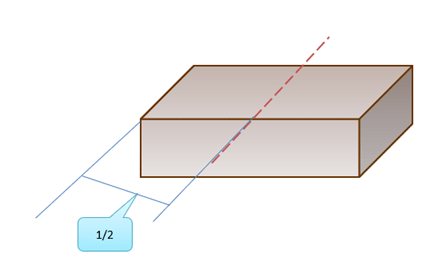
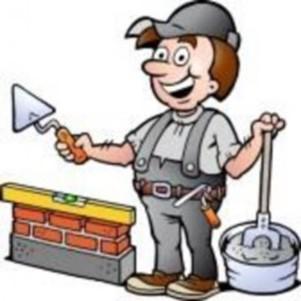
Bat 3/4
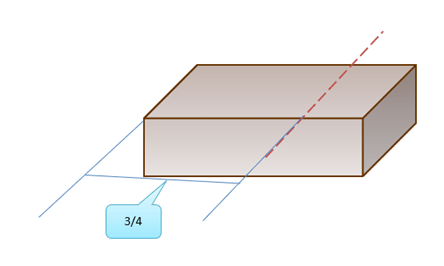
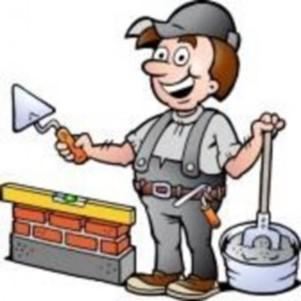
Bevelled Bat
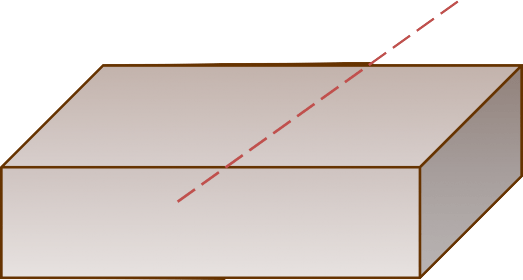

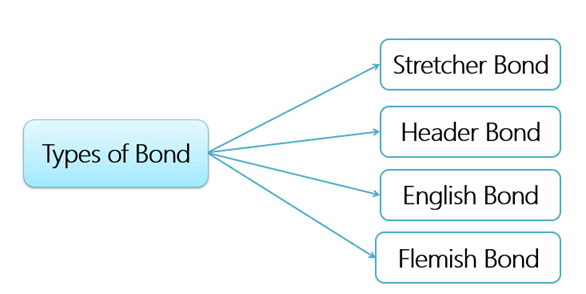
Stretcher Bond

Header Bond

English Bond
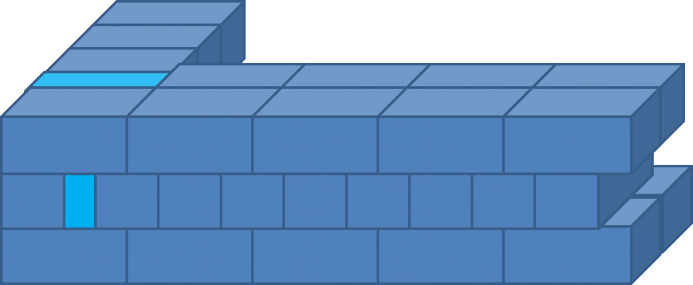
Flemish Bond
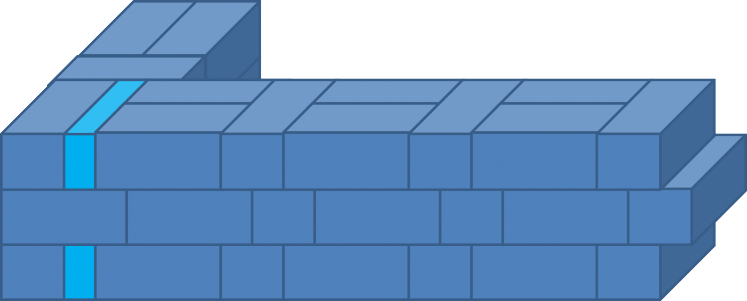
Corner Junctions (English Bond & Flemish Bond)
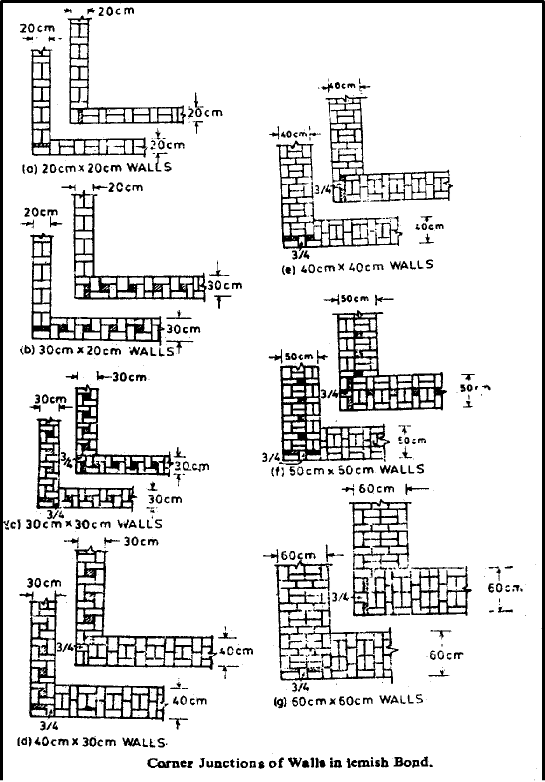
Tee Junctions (English Bond & Flemish Bond)
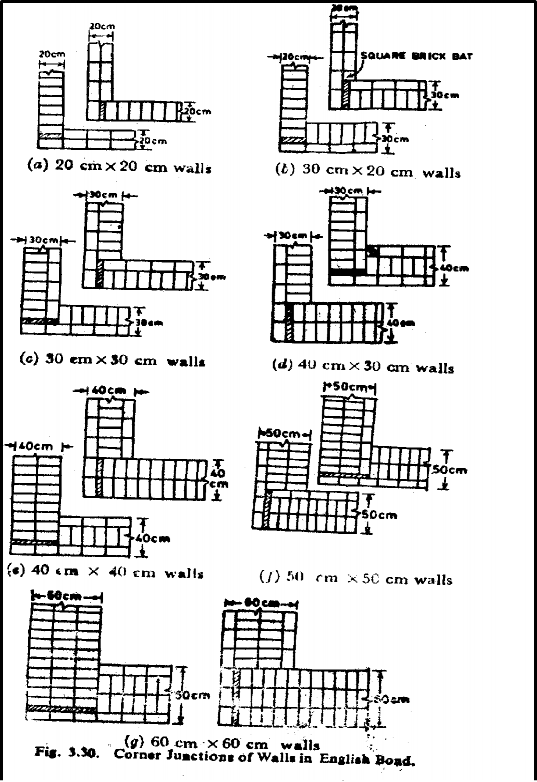

Cross Junction & Squint Junctions

Test for Bricks
A brick is generally subjected to the following tests to find for the construction work,
- Absorption
- Crushing strength
- Hardness
- Presence of soluble salts
- Shape and size
- Soundness
-
Structure
- Absorption:
A brick is taken and it is weighed dry. It is then immersed in water for a period of 24 hours. It is weighed again and the difference in weight indicates the amount of water absorbed by the brick. It should not in exceed 20 per cent of weight of dry brick.
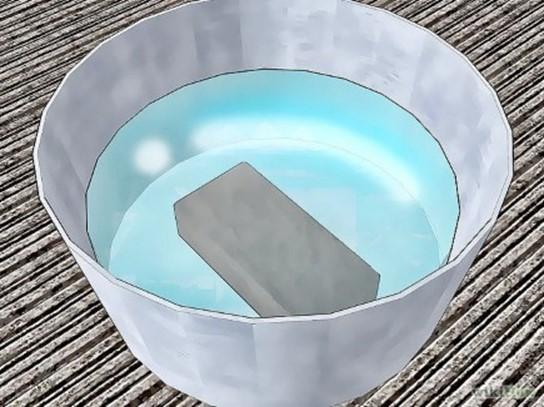
- Absorption:
2.Compressive/Crushing strength of Bricks:
The crushing strength of a brick is found out by placing it in a compression testing machine. It is pressed till it breaks.

3.Hardness test on bricks:
In this test, a scratch is made on brick surface with the help of a finger nail. If no impression is left on the surface, the brick is sufficiently hard.
4.Presence of soluble salts:
1.The soluble salts, cause efflorescence on the surface of bricks.
2.For finding out the presence of soluble salts in a brick, it is immersed in water for 24 hours. It is then taken out and allowed to dry in shade.
3.The Presence of white deposits on indicates presence of soluble salts.
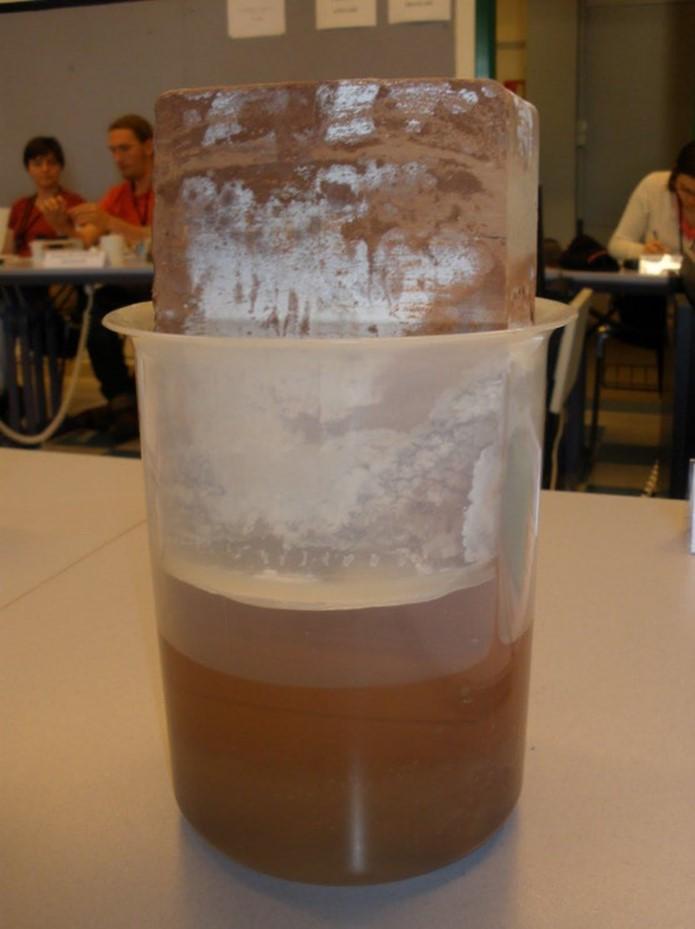
4.Presence of soluble salts:
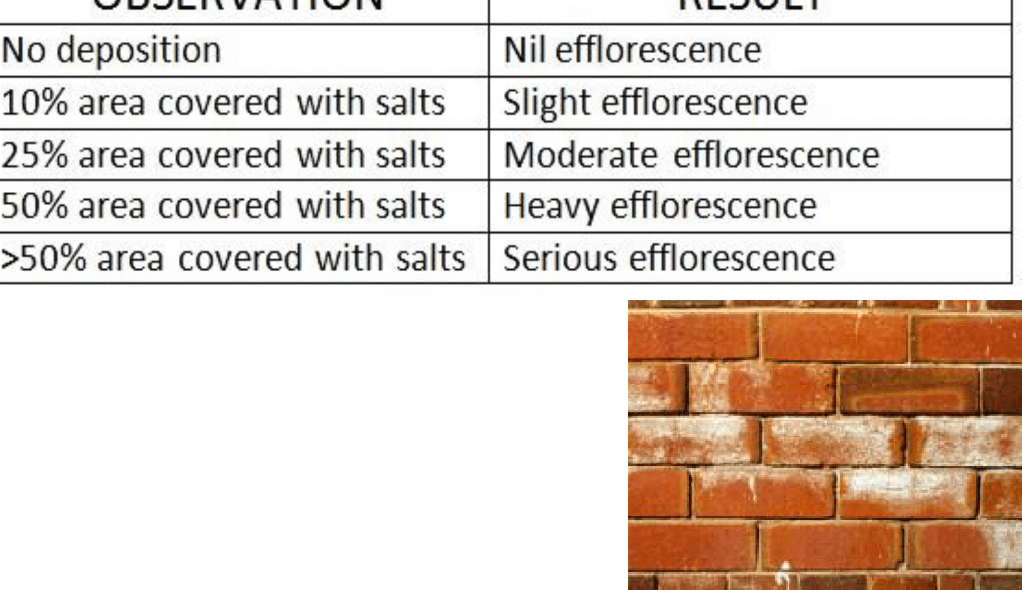
5.Shape and size:
1.In this test, a brick is closely inspected. It should be of standard size and its shape should be truly rectangular with sharp edges.
2.For this purpose, 20 bricks of standard size (225 mm x 112.5 mm x 75 mm) are selected at random and they are stacked lengthwise, along the width and along the height.
3.For good quality bricks, the results should be within the permissible limits
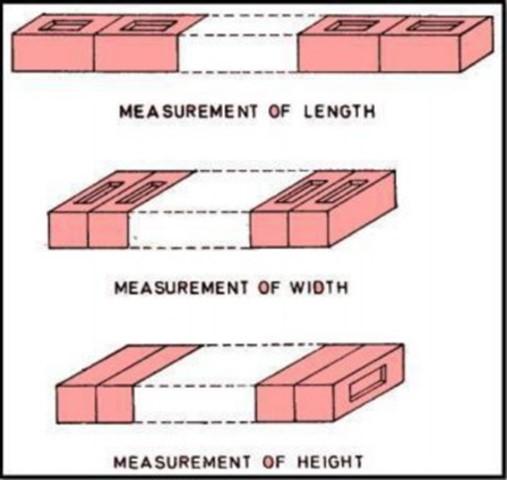
6.Soundness test on brick:
In this test, the two bricks are taken and they are struck with each other. The bricks should not break and a clear ringing sound should be produced.
7.Structure of a brick:
A brick is broken and its structure is examined. It should be homogeneous, compact and free from any defects such as holes, lumps, etc.
Classification of Bricks
The classification of bricks is as follows:
(i)unburnt or sun-dried bricks; and
(ii)burnt bricks.
The unburnt or sun-dried bricks are those bricks
-
which are dried with the help of heat that is received from sun after the process of moulding.
-
The unburnt bricks can only be used in the
construction of simple temporary and cheap structures.
-
Unburnt bricks should not be used at places
exposed to heavy rains
Classification of Burnt Bricks
The bricks used in construction works are burnt bricks and they are classified into the following four categories:
1.First class bricks
2.Second class bricks
3.Third class bricks
4.Fourth class bricks
First class bricks:
Specifications:
- Plain surface, sharp edges and size with tolerance in dimensions +3%
- Uniform red or brownish colored.
- High crushing strength, not less than 10.7 N/mm2
- Machine moulded
- Efflorescence- NIL
-
Water absorption less than 15%.
USE: They are used for the exterior wall brick works, short columns and arches.
Second class bricks:
Specifications:
- Slightly uneven faces and edges with tolerance in dimensions +8%
- Uniform colored but may be slightly over burnt.
- High crushing strength, not less than 7 N/mm2
- Hand moulded
- Efflorescence-Little (0 to 10%)
- Water absorption less than 20%.
- Slightly uneven faces and edges with tolerance in dimensions +8%
USE: They are used for internal walls and compound walls.
Third class bricks:
Specifications:
- May be distorted with blunt edges.
- Over burnt or under burnt and non-uniform color.
- Crushing strength, not less than 3.5N/mm2
- Hand moulded
- Efflorescence- Large (10 to 50%)
-
Water absorption less than 25%.
USES: They are used for flooring, paving, small brick foundations and brick blast.
Fourth class bricks:
These are overburnt bricks with irregular shape and dark colour.
These bricks are used as aggregate for concrete in foundations, brick floors, surkhi, roads, etc. because of the fact that the overburnt bricks have a compact structure and hence they are sometimes found to be stronger than even the first class bricks.
It is thus seen that the above classification of bricks is based on the of manufacturing or preparing bricks.
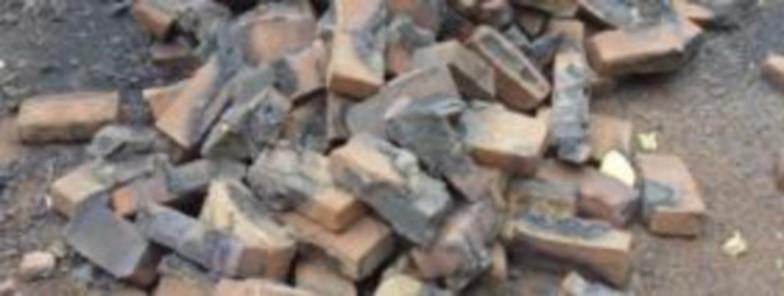
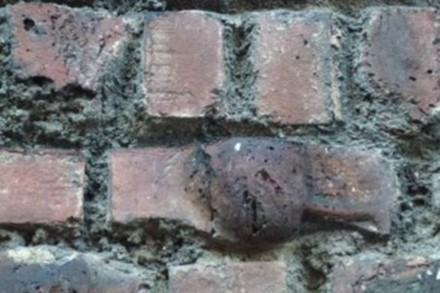
Classification based on shape
The ordinary bricks are rectangular solids. But sometimes the bricks are given different shapes to make them suitable for particular type of construction. Here we have enlisted different types of bricks available with various shapes:
Bullnose brick:
-
A brick moulded with a rounded angle is termed as a bullnose.

-
This type of brick is used for a rounded quoin.
Channel bricks:
1)These types of bricks are moulded to the shape of a gutter or a channel and they are often glazed.
2)These bricks are used to function as drains..
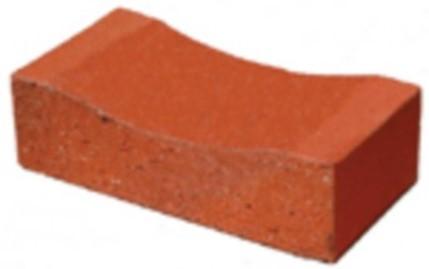
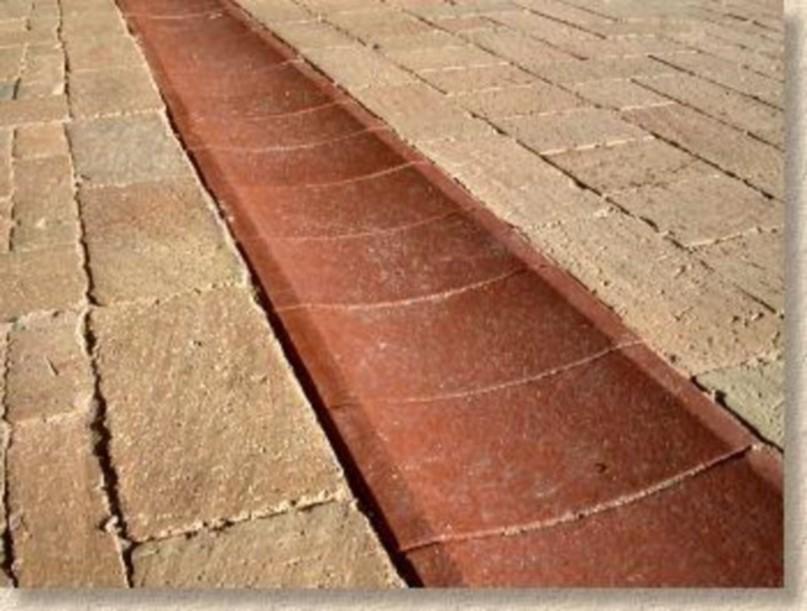
Coping bricks:
It is provided at the top of a wall to avoid dampness. They are specially designed bricks to cover the tops of brick parapet walls.
These bricks are made to suit the thickness of walls on which coping is to be provided.
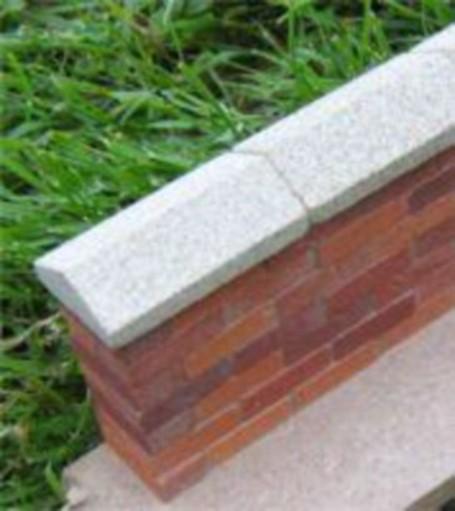
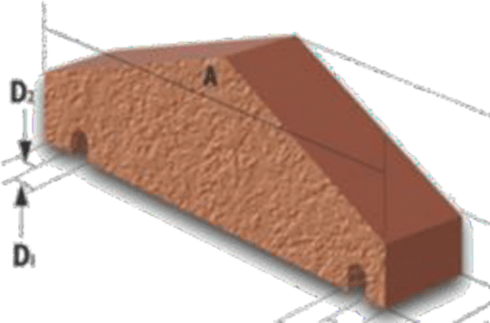
Hollow bricks/blocks:
1)They are light in weight about one-third the weight of the ordinary brick of the same size.
2)These bricks leads to speedy construction.
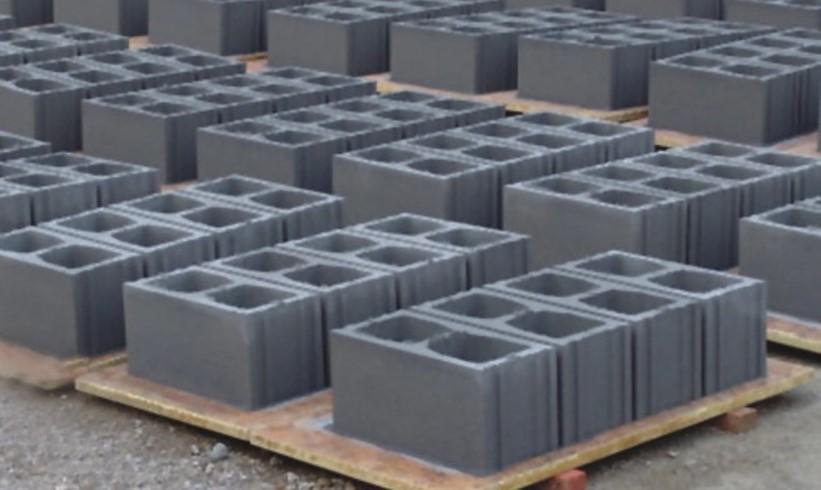
3)They also reduce the transmission of heat, sound and damp.
Paving bricks:
1)These bricks are prepared from clay containing a higher percentage of iron.
2)Such bricks resist better the abrasive action of traffic.
3)The paving bricks may be plain or chequered.
4)These bricks are extensively used for garden walks, street pavements, stable floors, etc. These types of bricks also render the floor less slippery.
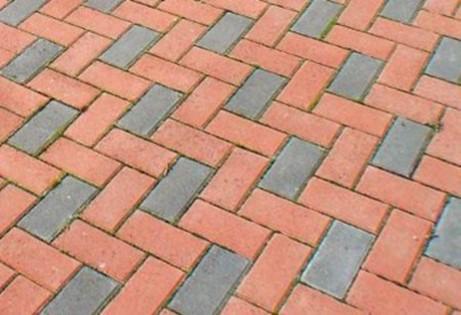
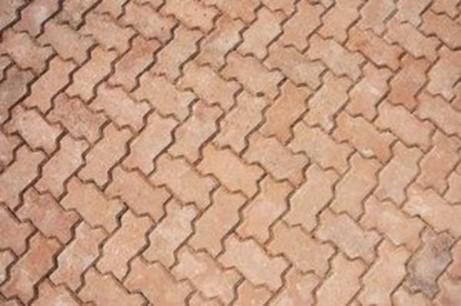
Perforated bricks:
1)These bricks contain cylindrical holes throughout their thickness.
2)These bricks are light in weight and they require less quantity of clay for their preparation.
3)The drying and burning of these bricks are also easy.
4)They may be of different shapes like circular, square rectangular or any other regular shape in cross-section.
5)The compressive strength of perforated bricks should not be less than 7 N/mm2 .
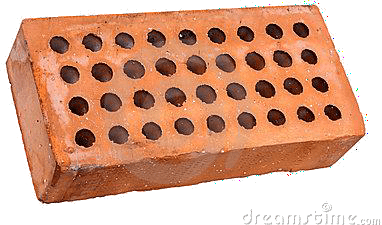

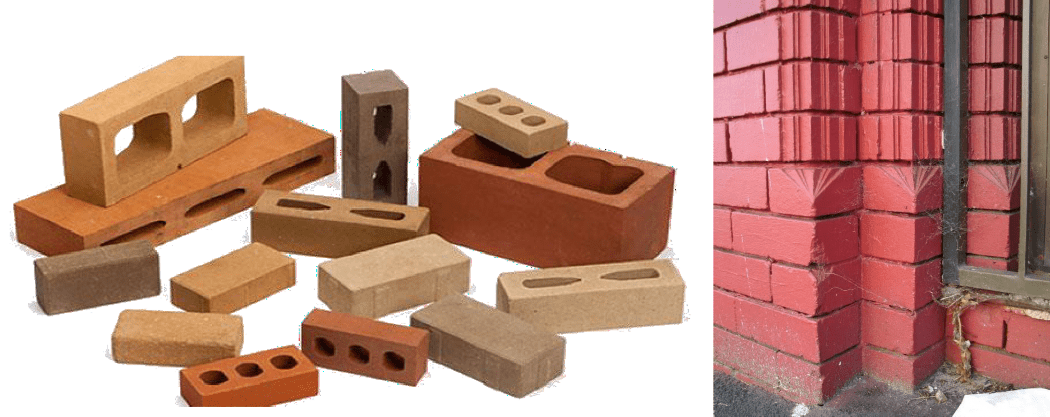
Purpose-made bricks:
1)n order to achieve certain purpose, these types of bricks are made.
2)Engineering bricks are prepared for constructions where high durability, compression strength and adequate resistance to sudden shocks are required.
3)These types of bricks are usually more costly than the ordinary bricks. But they grant safe, clean and quick construction.
Masons tools in Bick masonry
- Trowel
-
Brick hammer

- Lines and pins
- Spirit level and water level
- Straight edge
- Plumb Line
- Mason’s square (guniya)
- Tape (steel)
Mason’s Tools
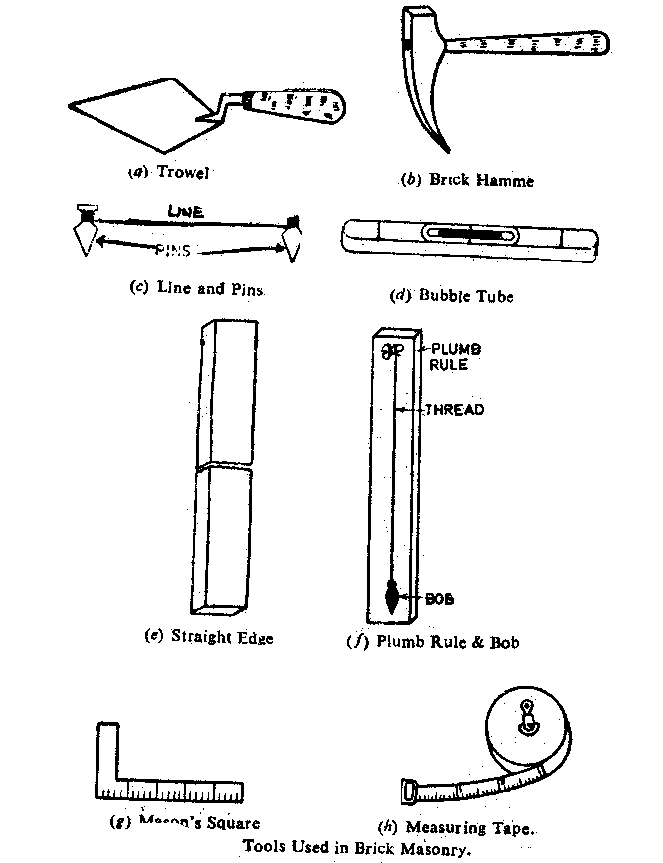
Use of Trowel & Lines and Pins
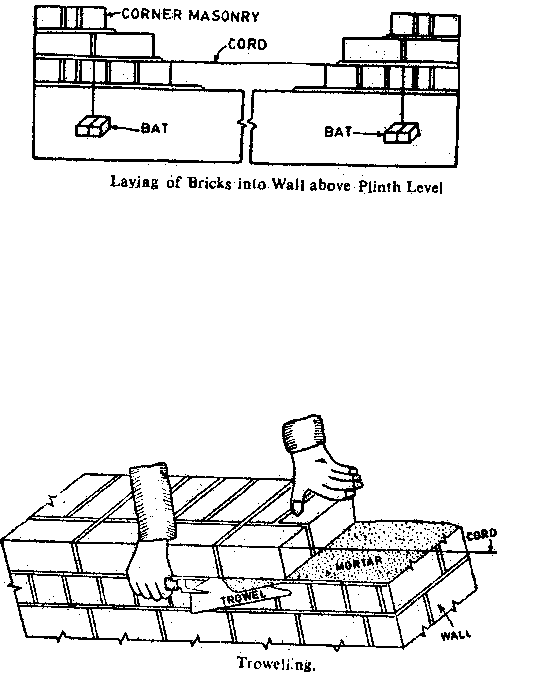
Use of Plumb
bob and Edge
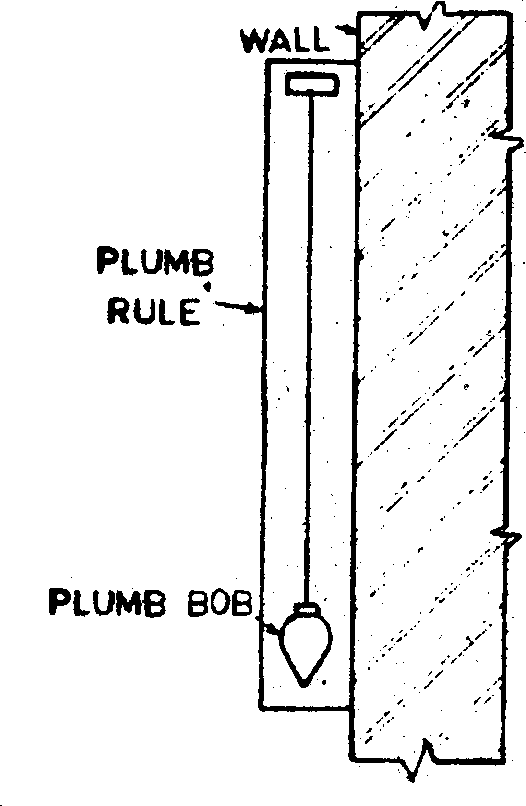
MANUFACTURING OF BRICKS
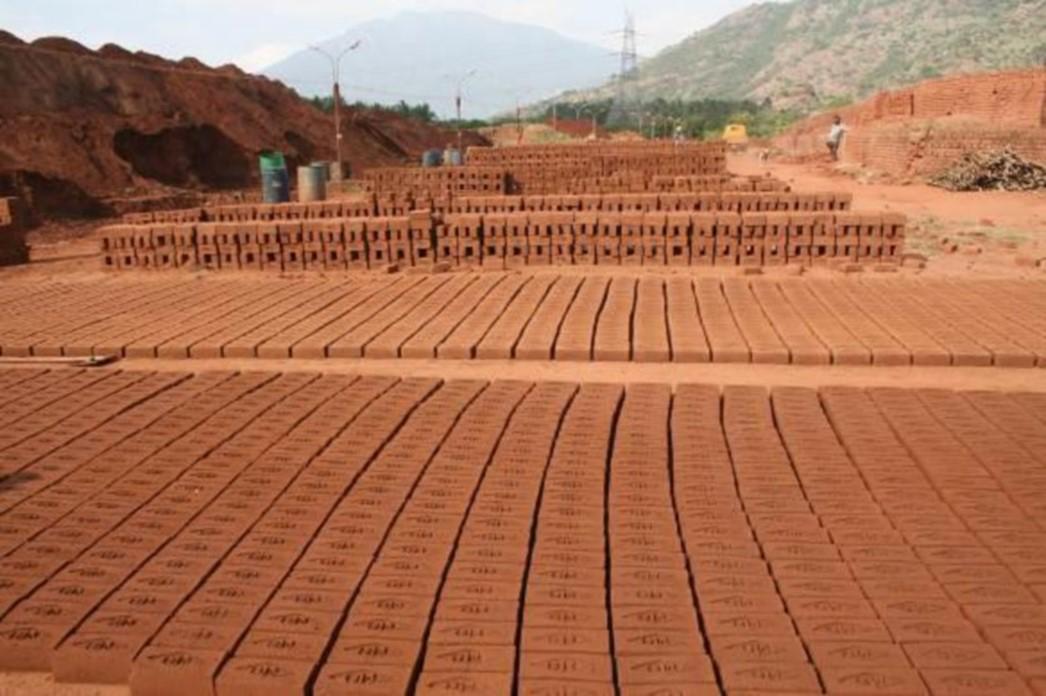
Clay Bricks
Manufactured from clay. The basic compositions of clay brick are:
- Silica (SiO2) – 60%
- Alumina (Clay) (Al2O3) – 20%
- Remaining ingredients – 20%
- Remaining ingredients such as:
Calcium oxide (Lime)
Iron oxide – give red colour
Manganese
Magnesium oxide
Functions of Ingredients
-
Silica –silica (sand), if added to clay in suitable proportion makes a brick hard and prevents it from warping and shrinking on drying.
-
Alumina – Alumina is main constituent of every clay. On the addition of water, clay becomes plastic and can be moulded into shape.
-
Lime – It helps to lower the fusion temperature, i.e. it helps silica to fuse at lower temperature and thus helps to bind the particle together. It also prevents shrinkage of raw bricks
Harmful ingredients
-
Alkalise – Lower the fusion temperature and melts the brick, changes it shape or get twisted. Also these salts have hygroscopic action.
-
Iron pyrites – During burning, iron pyrites due to high temperature oxidise, decompose and disintegrate brick into pieces.
-
Organic matter –Although the presence of organic matter in brick helps it burning, this causes porosity in the bricks. The presence of organic matter such as roots, dry leaves, in brick should be avoided.
MANUFACTURING OF BRICKS
- Preparation of brick earth
- Moulding of bricks
- Drying of bricks
- Burning of bricks
MANUFACTURING OF BRICKS
Removal of loose soil
The top layer of the loose soil about 30 cm depth contains a lot of impurities
like organic matter and hence it should be taken out and thrown away.
Digging, spreading and cleaning
The earth is then dug out from the ground. This earth is spread into heaps
about 50 to 150 cm height.
Weathering
The earth is then exposed to atmosphere for softening. The period may be of few weeks to a season.
Blending and tempering
The clay is then mixed with suitable ingredients. It is carried out by taking a small portion of clay every time and by turning it up and down in vertical direction (Pug Mill).
MATERIAL PREPARATION


Pug Mill

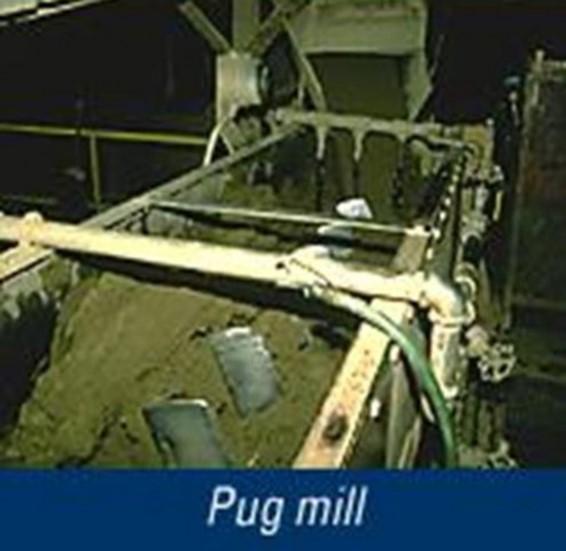
MOULDING
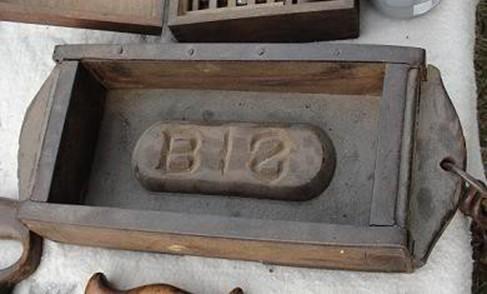
Hand moulding
When moulding is done with hand it is called hand moulding.
A wooden rectangular mould made in the shape of a brick is normally used for this purpose.
Machine moulding
The clay is placed in the machine, it comes out through the opening under pressure.
It is cut to bricks by steel wires fixed into frames.
DRYING OF BRICKS
-
Wet brick from molding or cutting machines contain 7 to 30 percent moisture, depending upon the forming method.
-
Before the firing process begins, most of this water is evaporated in dryer chambers at temperatures ranging from about 38 ºC to 204 ºC (100 ºF to 400 ºF).
-
The extent of drying time, which varies with different clays, usually is between 24 to 48 hours.
- Heat and humidity must be carefully regulated to avoid cracking in the brick.
- Preparation of brick earth
BURNING OF BRICKS
-
INTERMITTENT KILN – CLAMP , SCOVE (Loading, unloading, Cooling, and Burning of bricks) Highly inefficient & labor-intensive.
Most common, most polluting Temporary Structures

A typical scove kiln.
- CONTINOUS KILN BURNING (HOFFMAN, BULL’S TRENCH, VERTICAL SHAFT ) These are permanent structures.
Burning is done continuously in kilns.
Bricks from kilns are of correct size, perfect shape and good quality. Rate of burning is also high in kilns.
But initial investment for kiln is very high.
There are two well-known continuous kilns:
- BULL’S TRENCH Kiln
- Hoffman Kiln
BULL’S TRENCH KILN
Bull’s trench kiln consist of a rectangular, circular or oval plan shape. They are constructed below the ground level by excavating a trench of the required width for the given capacity of brick manufacturing.
This Trench is divided generally in 12 chambers so that 2 numbers of cycles of brick burning can take place at the same time for the larger production of the bricks.
Once fire is started it constantly travels from one chamber to the other chamber, while other operations like loading, unloading, cooling, burning and preheating taking place simultaneously.
Its manufacturing capacity of about 20,000 bricks per day.
BULL’S TRENCH KILN
Used in India, Pakistan, Nepal, Bangladesh
“Movable chimney” (MC) and “Fixed chimney” (FC)
MCBTK banned (but still used) in India, parts of Nepal & Pakistan due to very high emissions

HOFFMANN KILN
The main difference between the Bull’s trench kiln and the Hoffman kilns are:
- Hoffman’s kiln is an over the ground structure while Bull’s Trench Kiln is an underground structure.
-
Hoffman’s kiln have a permanent roof while Bull’s trench Kiln do not have so it former can be used in 12 months a year to manufacture bricks but later is stopped in the monsoon season.
Hoffman’s kiln is generally circular in plan, and is constructed over the ground. The whole structure is divided into the 12 chambers and all the processes takes place simultaneously like in Bull’s trench Kiln.
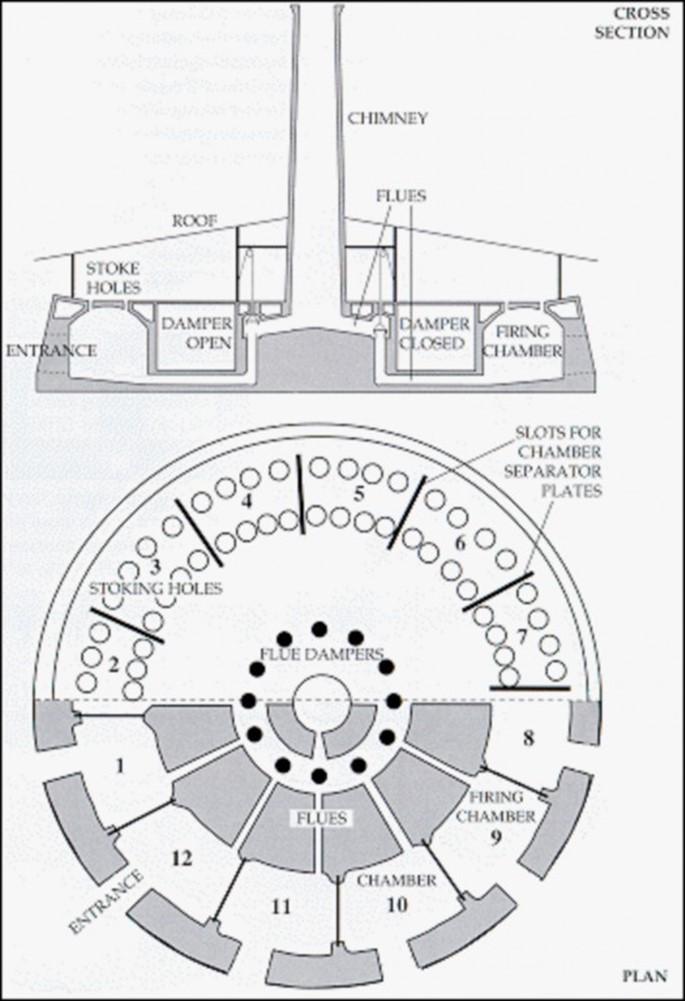
HOFFMANN KILN – ORIGINAL
HOFFMANN KILN – MODERN & HYBRID
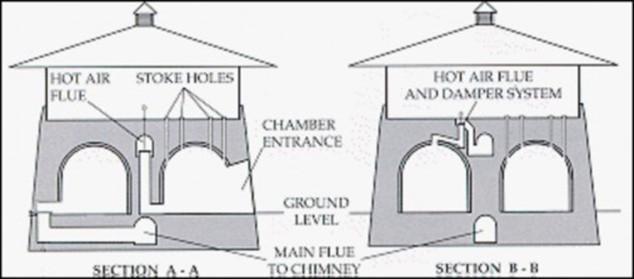
-
Widely used in China
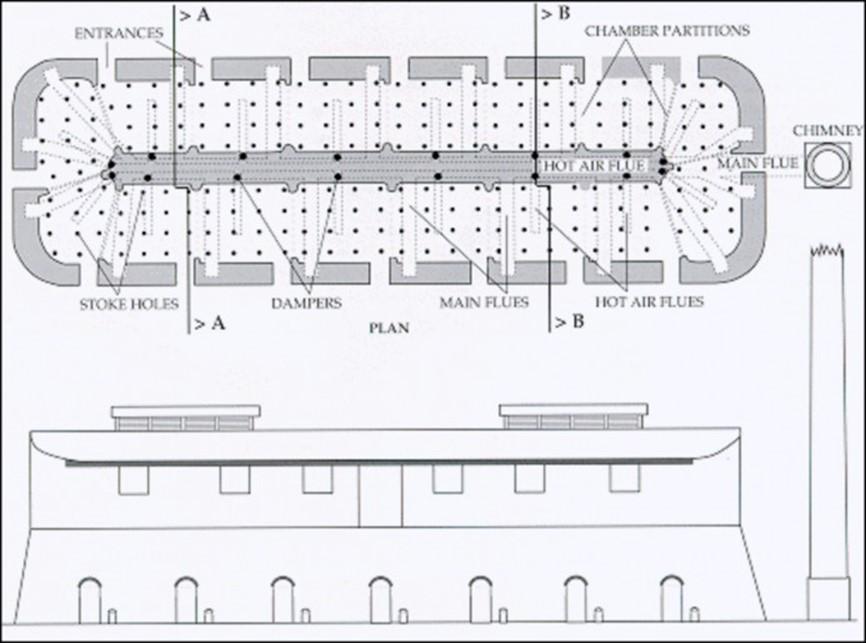
= 90% of bricks Can use coal or natural gas
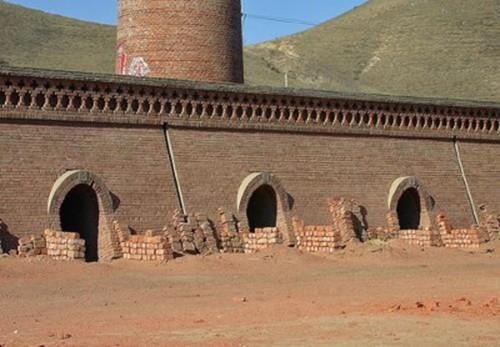
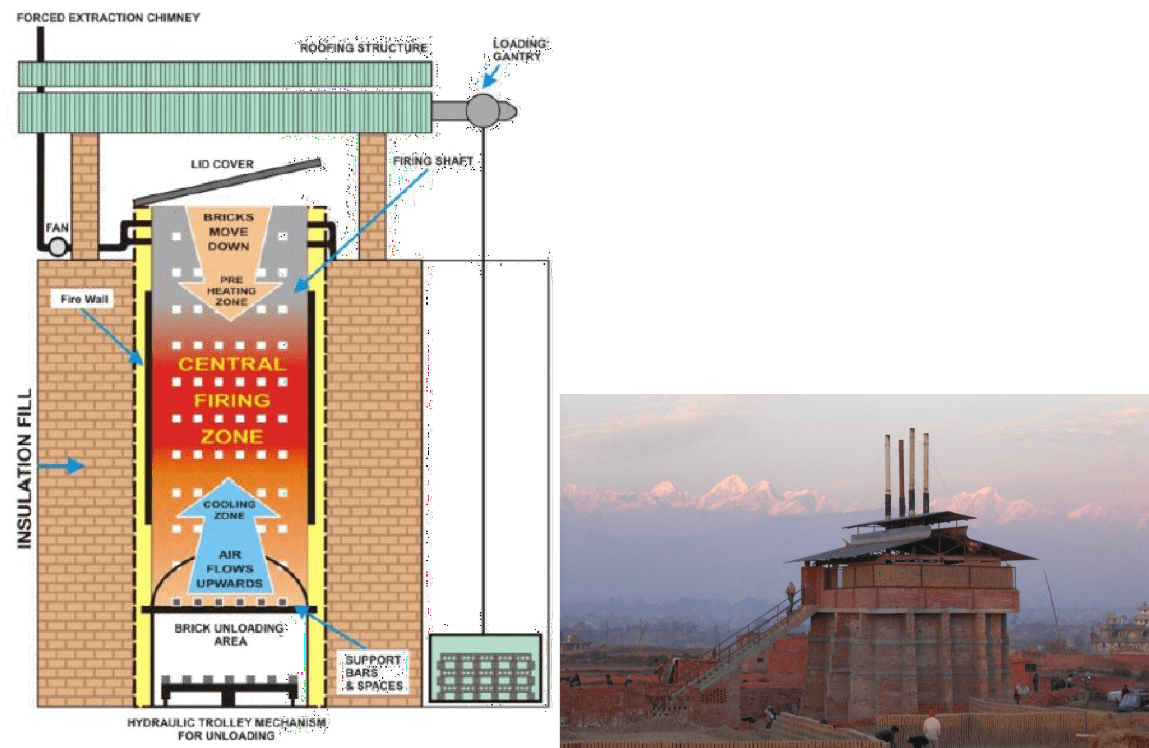
VERTICAL SHAFT BRICK KILN (VSBK)
Loaded at top, bricks removed from bottom
- High efficiency, low emissions
- Kiln of choice for aid agencies India, Nepal, Pakistan, Vietnam
- High efficiency, low emissions
-
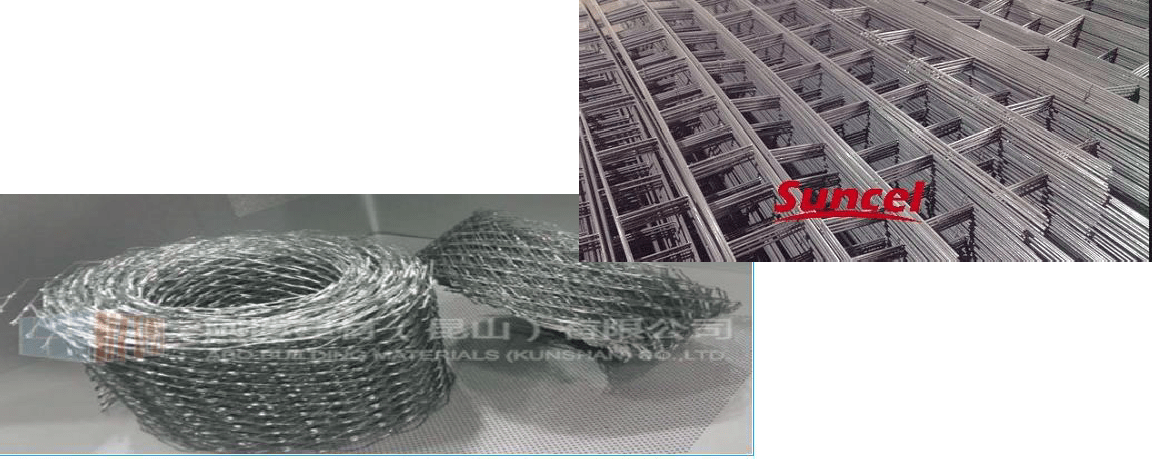
Reinforced brick Masonry
-
The brick masonry done by embedding reinforcement in rich cement mortar is called Reinforced brick masonry.
-
Reinforcement used may be in the form of
- Steel bars
- Hoop iron
- Wire mesh
Reinforced Brick Masonry
- Steel bars
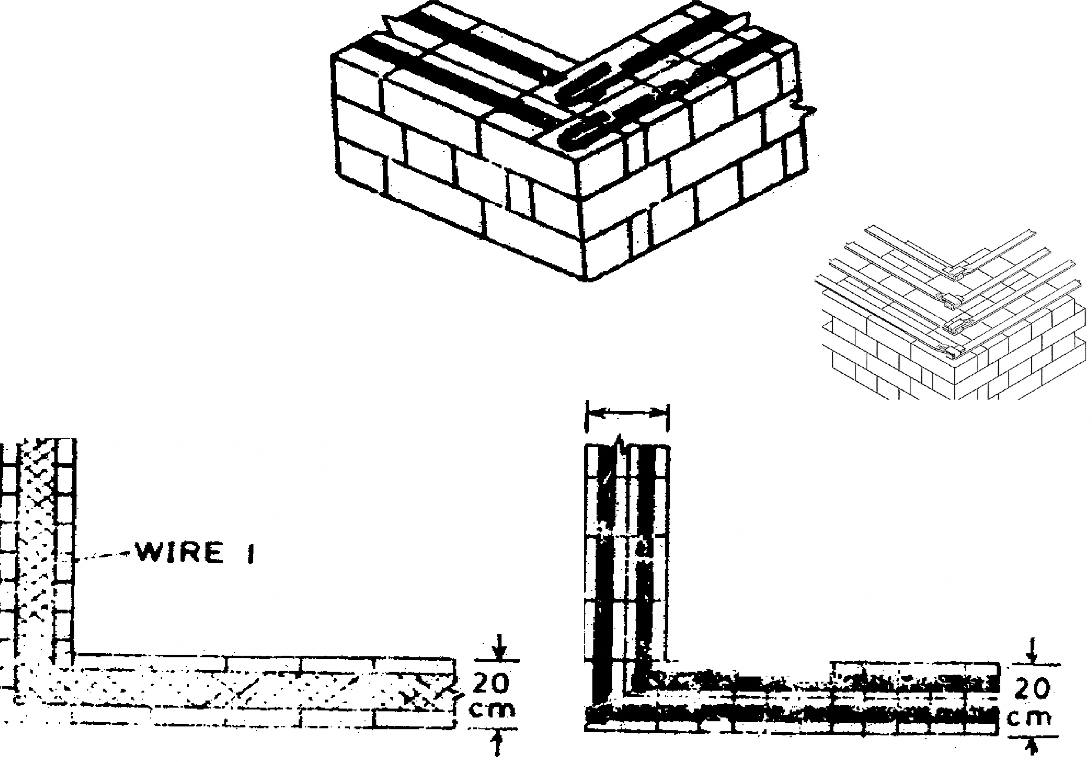
Constructions of Brick Masonry
-
It is the art of laying bricks in a proper bond with specified mortar to form a structure.
It involves the following activities…
- Selection of bricks
- Stacking of bricks
- Soaking of bricks
- Preparation of mortar (ASTM Specifications C 270, “Mortar for Unit Masonry”)
-
Laying of bricks
General Principles and precautions in Brick Masonry
- English bond should be used if not specified.
- Bricks used should be well burnt and should be uniform in size, shape and colour.
- For facing work selected bricks should be used.
- Curing of bricks should be done for at least 2 hours.
- Bricks should be laid with frogs pointing upward or as specified by the Engineer In charge.
- Mortar used in brick masonry should be of good quality.
- Brick bats are avoided.
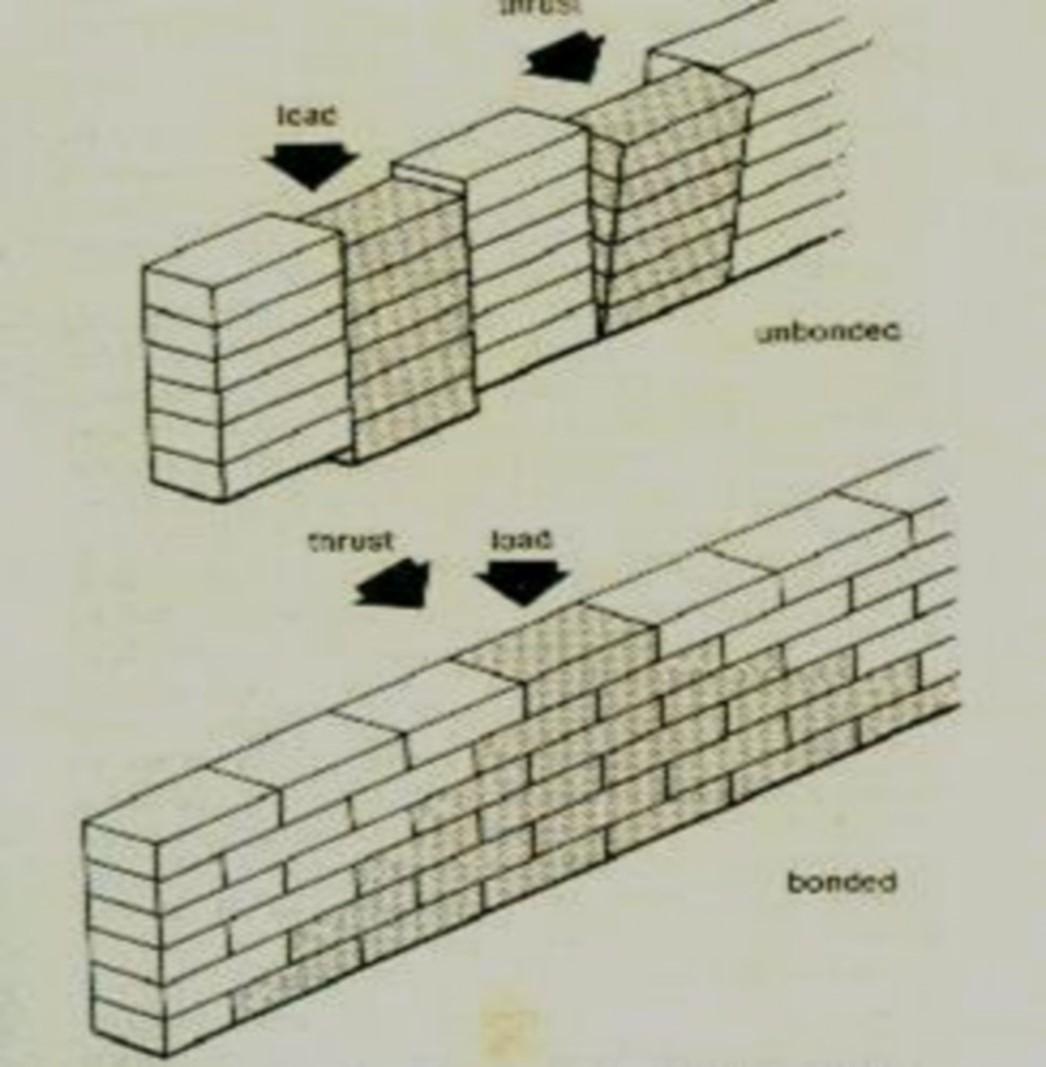
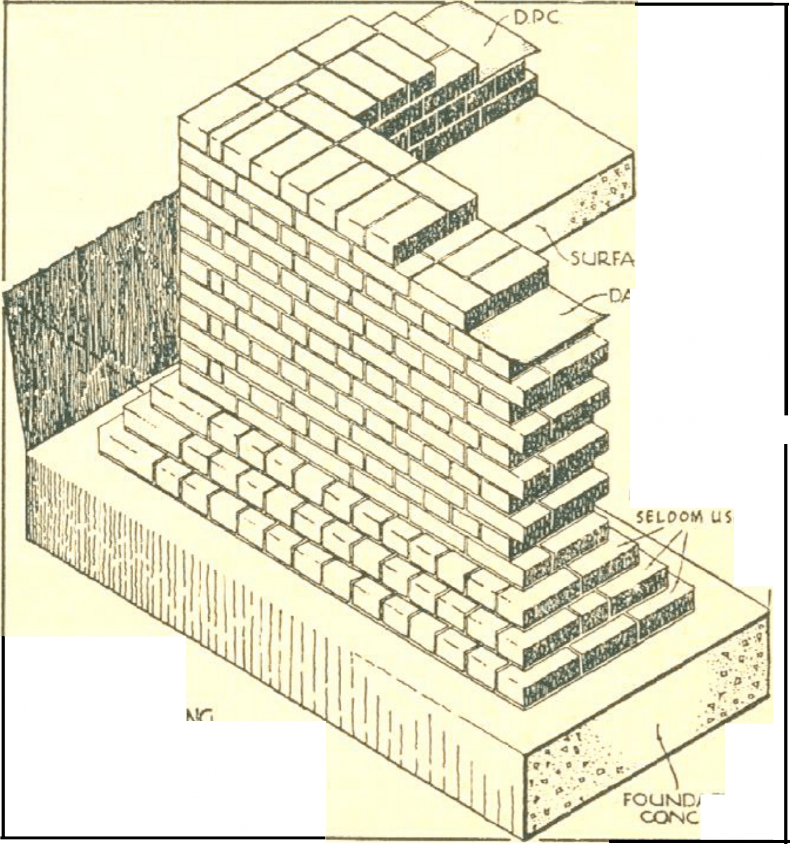
Piers of Bricks

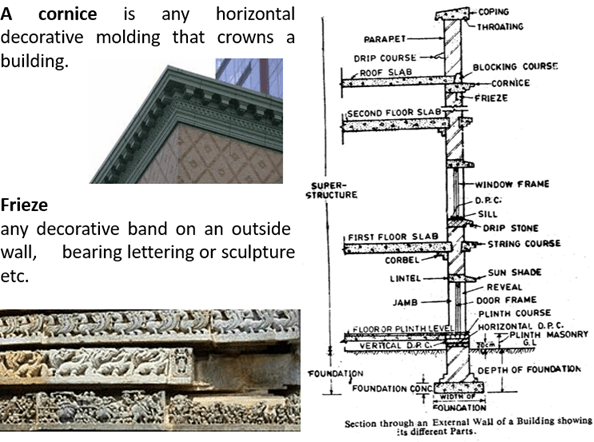
Advantages of Brick
- Brick will not burn, buckle or melt.
- Brick will not rust and corrode.
- Brick will not require constant maintenance.
- Economical (Raw material is easily available)
- Hard and durable
- Compressive strength is good enough for ordinary construction
- Different orientations and sizes give different surface textures
- Reusable and Recyclable
- Highly fire resistant
Disadvantages of Bricks
- Time consuming construction
- Cannot be used in high seismic zones
- Since bricks absorb water easily, therefore, it causes fluorescence
- Very Less tensile strength
- Cleaning brick surfaces is a hard job
- Color of low quality brick changes when exposed to sun for a long period of time






